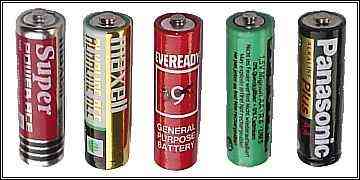| OddMix ELECTRONICS - BATTERIES |
Recharge Disposable Primary Cells Save Money Time Environment
For those of you who visited Europe in the past few years and tried to procure fresh batteries for your camera, radio or any other purpose, are no doubt had found out what it means to conserve. Disposable batteries in most countries there cost almost as much, or in some cases more, than rechargeable batteries of the same size. The chief reason for this is that European Union member countries are truly concerned about their environment and their governments are actually governs. Recycling is not just an empty phrase over there, but it is something many Europeans truly practice.
 |
| Picture 1. Carbon zinc and alkaline type "AA" cells |
Battery cells have two major classes - primary and secondary. The disposable kind - pushed and heavily promoted all over in America - is the primary type, and the hard to find (in the US) are the rechargeable, secondary cells. Primary cells generate enormous profits to the entire chain of the stores involved in their handling and distribution, at the expense of the general public. Using disposable batteries is the most expensive way to obtain electricity. That is precisely why disposable batteries are being pushed so eagerly, and why the distribution of rechargeable cells in the US are only grudgingly tolerated.
Here is how you may endanger the well being of our sacred economy, while improving the environment by recharging "non-rechargeable" primary cells. Yes, by all means feel free to charge those carbon zinc and some other cells - Picture 1. In spite of Mr. Faraday's observations over a century ago about reversibility in electrolytic systems, most of you had seen countless warnings against recharging primary cells. The messages are visible on the cells, their packaging materials, and in often repeated, well-placed, infomercial help messages. The messages are all warning us NOT to ever think of recharging any of those precious batteries or we shall lose all of our life, liberty, and our happiness. Fortunately many primary cell operation is reversible. And the sooner is that reversal cycle (the charging) happens the better.
![Picture 2 - Charger, battery cells and the essential plastic container [13 KB]](px/pwr_recharge_disp_cells_p2.jpg) |
| Picture 2. Charger, battery cells and the essential plastic container |
All the cell rejuvenation process requires is an inexpensive standard Nickel Cadmium [Ni-Cd] or the newer Nickel Metal Hydride [Ni-MH] battery charger, a voltmeter, a timer, a few exhausted batteries, a plastic container and some patience - Picture 2. It stands to reason that partially exhausted primary (or secondary) cells would recharge better than those completely run down.
Use a digital voltmeter to measure the open circuit voltage (voltage without any load across the cell) of the primary cells. Analog meters are every bit as useable as the digital type, especially if they have a 2 Volt FS (Full Scale) range, but the reading on the analog instrument is somewhat more difficult. New, unused primary cells should read around 1.5-1.6 V. When the battery is used a bit but still very reversible, this voltage gets down to around 1.3 - 1.4 Volt. Occasionally (mostly out of curiosity) I recharged batteries with a much lower voltage, but I found that doing that is usually not a very profitable occupation. The best kind of battery for rejuvenation is the least expensive carbon zinc or dry battery. It is usually branded as standard or super duty but never marked as alkaline. Alkaline types are not as easily rechargeable as the carbon zinc type and unless can't be avoided they should not be bothered with.
![Picture 3. Ruptured alkaline cell [3 KB]](px/pwr_recharge_disp_cells_p3.jpg) |
| Picture 3. Ruptured alkaline cell |
The actual recharging procedure is simplicity itself. Just put the battery into the charger and set the timer to ten minutes. When the timer signals the end of the charging time, remove the batteries and place them into the plastic container. The purpose of this container is to hold all of the recharged batteries for 24 hours. It is essential not to skip this step! Because of their construction, some of the cells may actually develop a leak - Picture 3, and it is not good to let the battery juice to come into contact with your precious powered items, or with your skin! For precisely the same reason NEVER put freshly recharged cells into your gadgets until the next day, when, after inspecting the cell, it would be safer to do so. The idea for this step is that the internal overpressure is the greatest upon termination of the charging. If a cell were about to rupture, usually the alkaline types, it would (usually) do so within the next 24 hours.
Internal battery pressure always builds during recharge and this pressure rises faster when the cell voltage is nearing its fully charged value - around 1.6 - 1.8 Volts. When working in that region shorter charge times are required. With batteries discharged to the 1.3 Volt level set the timer to a longer time like 30 minutes. However, two 15 minutes charging periods with some rest time in between them is always better than all of the charging time at once. Be especially careful and wear protective glasses when working with electrolyte (battery fluid) containing devices! Always protect your eyes and wash your hands if they happen to come in contact with cell electrolyte!
| Copyright © 2015 K Nagy - http://www.OddMix.com - All Rights Reserved Page Revised: 2015-01-01 - - Privacy Policy - Site Map - Support |  |